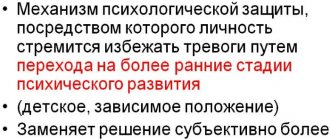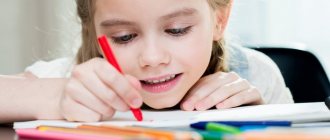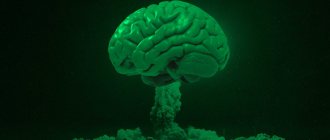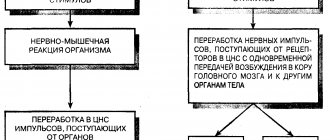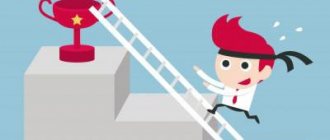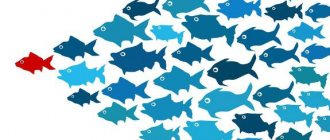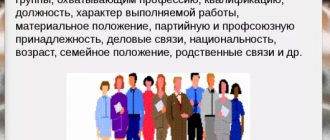All people are different, it’s hard not to notice. But they differ not only in appearance or character traits, but also in their abilities. And we all, to be honest, no, no, let’s sigh enviously - well, there are capable and talented people, and why don’t we have such talents? Abilities are one of the significant, valuable qualities, because success, fame, and material well-being are associated with them. What is this, maybe a gift from God, and someone has it, but someone is deprived? Let's figure out whether it's worth complaining and envying or whether it's better to gain these abilities and be proud of yourself.
Definition of the term “ability” in psychology
In psychology, abilities are properties of the human psyche, determined by the special development of functional organs and psychological structures, which allow him to master new knowledge, skills and abilities in a specific field of activity with particular speed and success.
For people who have certain abilities (in a specific field of activity), the speed of mastering new knowledge and skills is several times higher than the effectiveness of development in this area for those people who do not have such abilities.
For example, if a child has mathematical abilities (ease of arithmetic calculations, good memory, pronounced logical thinking), it is much easier for him to study mathematics and solve complex problems, unlike a child who does not have these abilities.
To successfully master and carry out different types of activities, different abilities are required. The speed and quality of acquiring new knowledge, skills and abilities in the relevant field of activity depends on them.
What do we call abilities?
This concept is not as clear as it seems, and therefore is explained by scientists in different ways.
Most precisely, this concept was formulated by B. M. Teplov, who proceeds from three ideas:
- abilities are individual properties of a person and, from the point of view of psychology, are inherent in every person
-but these are not all properties, but only those with the help of which success in life is achieved
- abilities do not include knowledge and skills that have already been accumulated by a person.
Abilities are manifested and preserved only in constant development, because, say, a musician ceases to practically maintain his form, his abilities are lost over time. A person develops and improves his abilities when he puts them into practice. It has been noted that to successfully complete a task, it is not enough to have any one ability; a combination of them is necessary, but it may happen that a less developed ability is compensated by another, more developed one.
Origin of abilities and their structure
There are 2 theories of the origin of human abilities. The theory of the emergence of abilities through the transfer of genetic information from parent to child and the theory of the development of abilities as a result of training, upbringing and the influence of the external social environment on a person.
The genetic theory of the emergence of abilities is based on well-known facts, when the children of outstanding scientists or artists also became scientists or achieved success in the relevant field of art. For example, a very common occurrence was the discovery of appropriate musical abilities in children of musicians (Mozart, Haydn).
Another striking example is the emergence of a whole dynasty of musicians and composers among the descendants of the famous great composer Johann Sebastian Bach.
The theory of the emergence of abilities under the influence of training and factors of external social influence is based on a number of experiments that confirm the development of almost any abilities, in the case of correct and systematic training of a person by experienced teachers, as well as as a result of proper upbringing in early childhood, when the main anatomical and physiological components are formed child's psyche.
As a result of the coexistence of these theories, modern psychology accepts them equally. The formation of abilities is influenced by both heredity and environmental factors, which can compensate for the lack of any innate abilities or, on the contrary, suspend their development.
The basic structure of abilities (in a general sense) consists of the following parts:
- Information part (knowledge about the world and society, scientific knowledge, knowledge about ways to carry out certain actions in various types of activities).
- The psychophysical part (experience in carrying out certain actions in the field of activity being mastered, expressed in specific skills and abilities).
- The creative part (the ability and willingness to find new types of solutions to any problems, the ability to create more effective skills and abilities).
- The emotional part (the ability to form positive emotions in relation to the activity being carried out, the ability to use emotions to more effectively master skills).
The presence of the above elements in the structure of abilities allows a person to effectively develop his abilities in any field of activity.
The development of individual elements of the ability structure affects the overall progress of the development of the ability itself, which in turn leads to a further strengthening of the development of its individual parts. Thus, the development of an ability is a mutual cyclical process involving the ability itself and its individual parts.
The structure of the ability of any specific activity, in addition to the general structure, will include a number of additional qualities that a person performing this activity must have.
For example, the structure of abilities that a person engaged in musical activity must have includes such elements as a sense of rhythm, an ear for music, and musical memory.
With regard to literary activity, in addition to the general structure of abilities, it should include such additional elements as clear functioning of the speech apparatus, a developed sense of aesthetics, the need for self-expression and fantasy.
Each specific type of activity has its own structure of abilities. A person carrying out any type of activity must have the appropriate abilities.
Concept and meaning
Abilities are:
- Mental formations that continue to develop into old age. You cannot compare abilities with knowledge or compare these concepts, but they cannot exist without each other.
- A system of mental properties, and not just the formation of the work of consciousness. The prerequisites for the emergence of abilities are the hereditary, physiological, and natural characteristics of the body. Conditions for development - education, training, influence of society. The dominant factors influencing the speed of skill development are personal interests, societal demands, and social values.
- A complex of properties that no longer manifests itself in knowledge, skills or abilities, but in the speed of their acquisition and further development.
Thanks to evolution and the development of society, people have learned to compensate for the lack of some abilities with the high development of others.
There are no incapable people, each person has a number of talents and inclinations and capabilities that set him apart from the general crowd, but often a person is not aware of his hidden capabilities. Many teachers approach teaching children in a formulaic way, not taking into account that each child is individual. Because of this, many children feel like “black sheep” and try not to show their uniqueness, fearing condemnation from classmates and teachers. This leads to late identification of abilities.
Thanks to evolution and the development of society, people have learned to compensate for the lack of some abilities with the high development of others.
Inclinations are the natural basis of abilities
Abilities are, in psychology, personality traits that determine the speed and quality of mastering knowledge, skills and abilities. The initial form of future abilities are inclinations, which are hereditary anatomical and physiological characteristics of the body, which can manifest themselves in the form of the following properties of the nervous system:
- Special perception of artistic forms, sounds or colors (the ability to recognize or analyze them, quickly memorize or reproduce them).
- High sensitivity of the nervous system.
- The pursuit of knowledge, high activity in public relations.
- Good memory and logical thinking, ability to analyze or generalize.
The difference between inclinations and abilities is that they are not specific and cannot specifically relate to any one activity or to any particular ability. The same inclinations can be used in the formation of different abilities in different fields of activity.
For example, excellent eyesight and innate attentiveness can become part of the abilities of an artist or professional archer. Different types of activities require certain abilities, which in turn can be based on the inclinations they require.
The makings of the visual system can be used in activities that require good vision (fine arts, sports). The inclinations of the speech apparatus can be successfully used in a field that requires a high level of its development (oratory, linguistics).
Inclinations are the basic “bricks” on which a person’s abilities and all professional activities are built. They begin to appear in preschool and early school age. During this period, the functional development of areas of the brain responsible for the coordination of the organs of movement, the logic of thinking, as well as the improvement of various analyzers occurs:
- vision;
- hearing;
- touch.
The discovered inclinations in the child must be developed in relation to the area of activity that interests him. As a result, the formation of abilities will take place more effectively and meet the necessary requirements of this activity.
Moscow State University of Printing Arts
6.
Chapter 6. ABILITIES
The concept of abilities. Inclinations as natural prerequisites for abilities. Classification of abilities. Giftedness. Talent. Genius
6.1.
The concept of abilities
A person’s successful activity is largely determined by the degree of development and formation of his abilities. A person’s abilities are not as obvious as, say, his external parameters, but we encounter them firsthand when several people who have equal training, conditions and the same desire to master some knowledge or skills achieve results of different levels in equal time.
Abilities are those individual psychological characteristics of a person that serve as a necessary condition for high-quality performance of a specific type of activity.
When we talk about abilities, we mean precisely the individual psychological characteristics of people. For example, all people are capable of walking upright and mastering speech, but we cannot attribute these functions to abilities themselves, since they do not have a psychological nature and are characterized by the sign of universality.
Abilities are most clearly manifested during training and retraining or in emergency situations; in normal situations, the success of activity depends on knowledge, skills, and level of training, and not on the abilities of the individual. Therefore, abilities are not reduced to knowledge, skills and abilities. So, a person can be very well technically trained and educated, but have little ability for any activity. For example, people who perform complex calculations in their heads phenomenally quickly often also have very average mathematical abilities.
Abilities are manifested not in knowledge, skills and abilities, but in the dynamics of their acquisition, i.e. in how quickly, easily and firmly they are absorbed by people, other things being equal. Abilities act only as some opportunity for acquiring knowledge and skills. Possibility turns into reality only in activities that cannot be carried out without the necessary abilities. For example, you cannot talk about a person’s ability to draw if he has not been taught to draw. Only through special training can one find out whether he has the ability to draw, how easily and quickly he learns working techniques, color relationships, and learns to see beauty in the world around him. It is known that when Surikov entered the Academy of Arts, the inspector, having looked at his drawings, declared that he should be prohibited from even walking past the Academy for such drawings. Based on the fact that the future great Russian artist did not have the necessary drawing skills, the inspector made a hasty conclusion about his complete unsuitability for painting.
If a person, other things being equal, cannot cope with the demands that an activity places on him, then this indicates that he lacks the appropriate abilities and means that, although the person will master the knowledge and skills necessary for this activity, this will require extreme effort from him with relatively modest results.
Abilities, like all other mental phenomena, have qualitative and quantitative certainty. Only by comparing qualitatively identical forms of activity can one assert that a particular person is more or less capable. Naturally, the comparison should be carried out only if equality of conditions is observed.
Abilities, in terms of their qualitative characteristics, represent a complex set of psychological properties of a person that ensure the success of activity. In other words, when qualitatively characterizing abilities, they take into account what a particular person is capable of, what abilities are involved in the process of activity as a prerequisite for its success. A qualitative characteristic of abilities allows a person to determine in which area of work he can achieve serious results. For example, a pronounced ability for pedagogical activity is determined by such psychological qualities as love for children and dedication to work, extensive knowledge and moral impeccability, the ability to quickly and accurately navigate educational tasks, pedagogical tact, initiative and sociability, endurance and self-control, etc. .
Finding out which specific psychological qualities meet the requirements of a given activity is closely related to a quantitative characteristic that answers the question to what extent these psychological qualities are developed in a person. To determine quantitative characteristics and measure abilities, various diagnostic techniques, tests, and trials are used. But, as a rule, they give an idea not about a person’s abilities, but about the presence of certain information, skills, and abilities. Therefore, at one time, L.S. Vygotsky proposed a method for determining the zone of proximal development to identify the level of a child’s abilities. The essence of this method is to assess the discrepancy between the results of solving a problem independently and solving the same problem with the help of an adult. If a child cannot solve a problem either independently or with the help of an adult, there is reason to say that the level of his abilities is not high enough. So, a quantitative description of abilities is possible through identifying the dynamics of a person’s success in the learning process.
6.2.
Inclinations as natural prerequisites for abilities
The question of the nature and origin of abilities is one of the most difficult in psychology. There are two diametrically opposed approaches to solving this issue.
Since the time of Plato, a concept has been developed that asserts the innateness (heredity) of abilities. As arguments, data are given on the early manifestation of abilities in the child. Thus, Mozart’s musical abilities were discovered at the age of three. Evidence of the heredity of abilities is also provided by the facts of their repetition in the descendants of outstanding people; examples of gifted families and entire dynasties are given. In the Bach family, musical abilities were first discovered in 1550, and dried up in 1800. In total, there were about sixty musicians in the Bach family, twenty of them outstanding, but J. S. Bach became especially famous.
Experimental studies on animals, in which only individuals that coped with the task more successfully than others were crossed, indicated the possibility of accumulating a genetic predisposition to successful learning.
From the point of view of another approach to the question of the origin of abilities, abilities are not something given by nature, innate, they are formed under the influence of the conditions of the social environment, training and upbringing. As arguments, facts of the massive development of certain special abilities, namely pitch hearing in the conditions of Russian and Vietnamese cultures, are cited here. Research by O.V. Ovchinnikova and Yu.B. Gippenreiter under the direction of A.N. Leontyev showed that pitch hearing, which forms the basis of musical hearing, is underdeveloped in one third of adult Russian subjects, while Vietnamese subjects showed one hundred percent musicality. And this is explained by the peculiarities of the Russian and Vietnamese languages: the first belongs to the “timbre” languages, and the second to the “tonal” languages. In the Vietnamese language, unlike Russian, the pitch of sound has the function of meaning differentiation. As a result, all Vietnamese children, mastering their native speech in early childhood, simultaneously develop their ear for music. As follows from this study, musical hearing can be formed under the influence of environmental conditions.
If the first concept about the innateness of abilities, in fact, ignores the need for intense activity to develop abilities, since they appeared on their own, then the second, on the contrary, argues that any activity can be learned even in the absence of desire and passion for it. Therefore, a more acceptable idea is that abilities are subject to the law of development, but their foundations are laid genetically. For example, people can, but animals cannot, master articulate speech and logical thinking. The limit here is set by the inclinations, which morphologically and genetically determine the maximum possibilities for improving the muscles of the larynx, the cerebral cortex, etc. Likewise, regarding abilities, psychology does not deny the innateness of the anatomical and psychophysiological characteristics of the human body, which may be conditions for the successful performance of any activity.
Morphological and functional features of the structure of the brain, sensory organs and movement, which act as natural prerequisites for the development of abilities, are called inclinations. In psychology, the catchphrase of Professor B.M. Teplov has become: “Ability is a deposit in development.” Thus, a person is born only with inclinations, these natural prerequisites for the development of abilities. Innate inclinations include, for example, such properties of the visual analyzer as accurate determination of proportions, color, etc., necessary for the successful development of artistic creativity, or the very subtle sensitivity of the olfactory analyzer, on the basis of which the professional abilities of perfumers-creators of new varieties of perfumes.
The mere presence of inclinations does not yet resolve the issue of the manifestation and development of abilities. For this to happen, it is necessary to engage in appropriate activities. Even the most pronounced inclinations can develop into abilities only through the process of work, learning, and play. Many outstanding people, about whom they are usually said to have talent from God, in their memoirs emphasized the leading importance of work in their creativity. Thus, Edison once said: “Genius is 1% inspiration and 99% perspiration.”
With hard work and great desire, you can develop abilities even in cases where there seem to be no inclinations for a particular type of activity. As an example, let us turn to the life of the outstanding orator of antiquity, Demosthenes. When Demosthenes set himself the goal of becoming an orator, he was a frail young man with a weak voice and short, intermittent breathing, in addition, he lisped and burbled. All this contradicted the image of an orator that had developed in Ancient Greece, who was supposed to have a beautiful figure, stately appearance, artistic facial expressions and gestures, and a beautiful loud voice. But Demosthenes did not deviate from his goal and began to work hard on his appearance, voice, diction, and breathing. In front of the mirror, he studied acting, put pebbles in his mouth and so recited poems from memory, while running, without taking a breath, he uttered several poems or some long phrase. By persistently developing inclinations that were poorly expressed from birth, Demosthenes essentially created himself anew. This became possible due to the fact that the goal set by Demosthenes to become an orator, prompted by his ardent desire to influence a huge mass of people with words, turned into an independent motivating force, a motive.
Thus, increased motivation and the intense activity of the individual caused by it are necessary conditions for the development of abilities.
It is sometimes very difficult to discern the makings of a person. This is evidenced by numerous examples from the lives of outstanding people. For example, Newton was considered stupid at school, and his parents were forced to take him home due to his learning disability. F. Chaliapin was not accepted into the choir “due to his inability to sing.”
The extent to which inclinations manifest themselves depends on the conditions of individual personality development. Unfavorable conditions prevent the preparation of deposits. For example, an impoverished environment in which a child is deprived of a variety of impressions and the opportunity to actively act, reduces the possibility of developing his abilities. Frequent mental trauma inflicted on a child in the process of improperly organized education and upbringing also creates unfavorable conditions for the development of abilities. A factor inhibiting the development of abilities can be incorrect handling of motivation. Thus, excessive coercion to any type of activity usually causes negative experiences that make it difficult to demonstrate special abilities.
Inclinations that are not developed in time can atrophy. It is known that children who, due to certain circumstances, ended up in the den of beasts and were thus deprived of the opportunity to develop their inclinations and abilities, lost them forever.
A person can discover and develop his abilities for a certain type of activity thanks not only to hard work, but also to training methods. Improving the methods of forming relevant knowledge and skills will ultimately lead to the fact that such abilities as poetic, musical, artistic, organizational, etc., which are usually spoken of as “innate,” will develop in the same way as, say, , grammatical or arithmetic abilities. In other words, just as now no one doubts the fact that any normal child can be taught to read and write, so it will be common practice to teach all children to write poetry, compose music, draw, etc. And today a lot is already being done in this direction. For example, there are experimental schools in which absolutely non-musical children develop a musical ear through a system of individual training.
An important factor in the development of a person’s abilities are inclinations and interests. An inclination is a personality trait that manifests itself in the preferential choice of engaging in a particular activity. Thus, a child’s increased propensity for visual activities serves as an indicator of his awakening abilities for artistic creativity. As a rule, a penchant for painting is accompanied by an interest in color, the peculiarities of the shape of surrounding objects, in everything that is in one way or another connected with the fine arts, and in artistic creativity in general. However, the presence of interests and inclinations in itself does not always mean that a person has the appropriate abilities. But the fact that interests and inclinations, like other character traits, such as perseverance and determination, are conducive to the formation and development of abilities in the process of activity itself is an indisputable fact.
6.3.
Classification of abilities
A unified and generally accepted classification of abilities in psychology has not been developed. The principles of its construction are proposed to be very different. Thus, according to the main types of activity, engineering, scientific, economic and other abilities are distinguished. Differences associated with the peculiarities of the functioning of the sense organs serve as the basis for dividing abilities into olfactory, musical, etc. Based on the strength of balance and mobility of nervous processes, say, in the motor sphere, various sports abilities are distinguished. The most common is the division of abilities into general and special.
General abilities are personality traits that are, to one degree or another, necessary for a wide variety of activities. These properties have such very specific psychological manifestations as observation, constructive imagination, the ability to operate with abstract material, etc. General abilities influence the formation of new knowledge and skills.
Since all people differ in the qualitative and quantitative composition of their inclinations and the conditions of development, over time individual differences become significant, and along with general abilities, special abilities are distinguished. Special abilities usually include abilities that meet a narrower range of requirements for a given activity. These can be psychomotor, sensory, mnemonic, intellectual and other abilities.
With the beginning of vocational training, new personality structures are formed, which are called professional abilities. Typically, professional abilities are not identified by psychologists as a separate group, but are considered as a type of special ability. But unlike special ones, professional abilities are formed at a much later age. In addition, they closely interact with inclinations: at critical moments in his professional activity, a person mobilizes all the resources of his psyche, including inclinations. This is not typical for amateur activities. As new professions are mastered, new professional abilities are formed, often in a completely different area. A person can be an excellent manager, journalist and writer at the same time and work professionally in all these areas.
The abilities, talent, vocal, auditory or visual exclusivity of the individual find their expression primarily in creativity. According to the remarkable Russian thinker S. Frank, every person, at least to a small extent, is a creator: his work always, even to a minimal extent, has a moment of creativity. If a craftsman works with love and taste, puts his personality into his work, then he, in fact, performs a creative act. In this sense, the difference between a craftsman and an artist is relative. Even the most ordinary person, in addition to simply performing his duties, brings into his work an element of flair, improvisation and, realizing his abilities, copes with an unforeseen situation in some new, unprecedented way for him.
The most typical example of creativity is artistic creativity. A person capable of artistic creativity has a number of developed spiritual and mental characteristics. American psychologist D. Gilford notes six such inclinations of a capable artist: fluency of thinking, associativity, expressiveness, the ability to switch from one class of objects to another, adaptive flexibility or originality, the ability to give the artistic form the necessary outlines.
Many people engage in artistic activity in one form or another at one time or another in their lives with greater or lesser success. However, only artistic abilities ensure the creation of artistic values of public interest.
There is a hierarchy of degrees that characterize a person’s predisposition to creativity: ability - giftedness - talent - genius.
A person who is on a higher rung of this creative ladder retains those positive qualities that are inherent in those who are located on its lower steps, but must certainly have a number of additional high virtues.
6.4.
Giftedness
Usually the concept of “giftedness” is used to characterize children, since the child’s activities are characterized by very relative success, independence and originality.
Giftedness is defined as a set of natural inclinations that serve as one of the conditions for the formation of abilities.
Psychological analysis of giftedness allows us to identify the general structure of abilities, consisting of such mental qualities that provide the opportunity to carry out a wide range of activities at the highest level. A study of children with pronounced talent for various types of activities showed that the following abilities are manifested in the vast majority of highly gifted children. Firstly, it is attentiveness, composure, constant readiness for hard work. Secondly, readiness to work develops into diligence, into an irrepressible need to work. Thirdly, this is high productivity of mental activity, which is expressed in the speed of thought processes, systematicity of the mind, and increased ability to analyze and generalize.
Observations of gifted children indicate that they exhibit a strong desire to engage in activities for which they are capable. They can literally spend hours every day doing something that interests them, without getting tired and without straining at all. For them this is both work and play. All their interests, experiences, searches, questions are concentrated around these activities. Yu.B. Gippenreiter talks about a boy who, at the age of three and a half, became interested in numbers. He spent many days at the typewriter, typing sequentially the natural numbers from 1 to 2000. Very soon he mastered the operations of addition and subtraction. The characters in his imaginary games were numbers, many of which had their own special character and behavior. He himself discovered negative numbers and the operation of multiplication.
The general abilities that form the structure of mental giftedness are supplemented by a number of abilities that meet the requirements of specific activities, which can only be carried out if the appropriate abilities are present. For example, artistic talent presupposes acute attention to life, the ability to select objects of attention, consolidate these impressions in memory, extract them from memory and include them in a rich system of associations and connections dictated by the creative imagination. Specifically, if a child is interested in literary creativity, then his literary talent will be characterized by such specific abilities as a high level of aesthetic feelings, the presence of vivid visual memory images, a sense of language, rich imagination, deep interest in the psychology of people, and the need for self-expression.
Domestic psychology proceeds from the fact that targeted training and education have a fairly strong influence on the development and formation of giftedness. In Western psychology, on the contrary, the concept has become widespread, according to which giftedness has a predetermined character. The authors of this concept believe that mental talent depends on personality genes and is only to a small extent susceptible to the influence of environment and upbringing. They argue that mental aptitude can be measured. Quantitative measurement is made using so-called tests. In terms of content, mental aptitude tests consist of tasks of varying degrees of complexity that do not depend on the experience and knowledge of the test subject and are verbal tests or various “puzzles”. The success of solving problems is calculated in the sum of points or points that each subject scored in a set time, and the coefficient of mental giftedness is determined. It is expressed as a percentage:
where IQ is the coefficient of mental giftedness, and mental age is determined by the average score.
For example, as a result of testing, two children of ten and a half and fourteen years old scored the same amount of points corresponding to the mental age of eleven and a half years. Then the coefficient of their mental talent is equal to:
The coefficient of mental giftedness is declared constant. Having established it at an early age, it determines a person’s ability to succeed in learning and practical activities for the rest of his life.
So, depending on the coefficient of mental giftedness, the most capable children are selected for education in specialized, privileged schools and higher educational institutions. In reality, this coefficient does not reveal the giftedness of children, but only the presence of certain information, skills and abilities.
6.5.
Talent
A person, as an unconditionally unique, unique and unrepeatable personality, in the process of creative activity, scientific, technical or artistic, expresses first of all his subjective experiences. A talented person, trying to express himself, at the same time brings something objective, universal to his creativity. Moreover, this is not done intentionally, but is born out of inspiration.
Inspiration is a specifically creative state of clarity of thought, the intensity of its work, the richness and speed of associations, heightened virtuosity in the sense of form, and deep insight into the essence of life's problems. Goethe said that there are moments when the scales seem to fall from our eyes, and the world suddenly appears naked to our senses, in its pristine pristineness, brightness and unusualness. Such moments can cause, he wrote, a special kind of eerie experience, reaching the point of fear. But most often, an “active pimp” comes to the rescue - reason, which quickly translates everything into ordinary cliches and patterns.
Inspiration gives rise to extraordinary creative energy and makes the creative process especially fruitful. Since ancient times, the image of inspiration has been the winged horse - Pegasus.
Thanks to inspiration, talent generates values that have enduring national and sometimes universal significance, while a gifted person creates values that have lasting significance for a particular society, albeit for a significant period of its development.
Science comprehensively explores the psychological aspects of human activity, including creativity, but nevertheless, today we can agree with the words of A.S. Pushkin that “every talent is inexplicable. How does a sculptor see Jupiter in a piece of Carrara marble and bring it to light, crushing its shell with a chisel and hammer? Why does the thought come out of the poet’s head already armed with four rhymes, measured in slender, monotonous feet? “So no one except the improviser himself can understand this speed of impressions, this close connection between his own inspiration and alien external will...”
In psychology, talent is defined as a favorable combination and interaction of abilities for a particular activity, ensuring the success of the creative performance of this activity.
The abilities that make up talent are not identical, since the structure of talent is determined by the nature of the requirements that a specific type of creative activity places on an individual. Therefore, the combination of mental qualities of the personality of a talented commander will be different than that of a talented architect.
Like abilities, talent is only an opportunity to achieve success in creativity. Ultimately, the acquisition of high skill in creativity depends on the historical conditions of human existence, and history, especially the Middle Ages and the Renaissance, provides confirmation of this. As N.A. Berdyaev wrote: “The Middle Ages, having concentrated and disciplined the spiritual forces of man, at the same time connected them. It kept them subordinate to the spiritual center; it centralized all human culture. This subordination was present in the entire structure of medieval culture. At the dawn of modern times, re-centralization took place and human creative powers were released. And so the effervescent time of these creative forces created what we call the Renaissance... This historical period stands under the sign of the release of human creative forces, spiritual decentralization, separation from the spiritual center, differentiation of all spheres of social and cultural life, when all areas of culture become autonomous. Science, art, public life, economic life, the entire public and all culture are autonomous.”
At the same time, human history is replete with examples indicating the poor adaptability of the social structure of a particular society to reliably support creativity and high spiritual activity. There are often serious discrepancies between society and a talented individual, and the artist is tempted to leave the world of officialdom into the solitude of free creativity. Examples of such solitude can be the flight of young Goethe to Italy, where he created “Roman Elegies”, Pushkin’s Boldino Autumn, N.K. Roerich’s departure to the Kullu Valley, Gauguin’s flight to Tahiti, etc.
Talent as a potential opportunity to create significant values in science, art, and social life, which can be realized in the products of the material and spiritual culture of society under appropriate social conditions, also requires a lot of creative, hard work. People whose talent was undeniable in the eyes of all mankind always worked hard. Emphasizing the leading importance of labor in his work, Goethe, for example, wrote: “I am considered the darling of fate. I don’t want to complain and criticize my lot. But in reality there was nothing in my life except hard work, and I can say now, at 75 years old, that in my entire life I have not lived even four weeks to my satisfaction. It was as if I was constantly dragging a stone up the mountain, which rolled down again, and I had to drag it up again.”
In the process of work, one accumulates life experience, the necessary set of skills and abilities, without which no creative success, the highest skill, or worldwide fame are possible. Mastery as a manifestation of an individual’s talent in activity is revealed not only in the sum of the relevant skills and abilities, but also in psychological readiness for the qualified implementation of any labor operations that will be necessary for a creative solution to the problem that has arisen.
6.6.
Genius
Genius is a holistic quality of the human personality. As N.A. Berdyaev wrote, “a man’s love for a woman, a mother for a child can be genius, caring for others can be genius, people’s inner intuition, not expressed in any products, can be genius, torment over the question of meaning can be genius life, searching for the truth of life. A saint may be characterized by genius in self-creativity, in transforming himself into a perfect, radiant creature, although he may not create any products.”
In other words, a person’s genius is manifested in the strength of his perception of the world and the depth of his influence on other people and is not necessarily expressed in the talent to write wonderful pictures or original scientific treatises, to be a great commander or an outstanding actor.
Thus, the concepts of “genius” and “genius” are not identical. Genius is born from the combination of the genius nature of the human person with talent. Genius creates the highest universal values that are ahead of the historical era and have global significance for all times. For example, geniuses in art were Leonardo da Vinci, Michelangelo, Rembrandt, I. Repin, V. Surikov and others. Moreover, the genius of Leonardo da Vinci extended not only to fine art, but also to many other types of art and science. Thus, he created drawings and designs for flying projectiles, which in general terms anticipated modern aircraft and missiles, developed designs for moving guns, reminiscent of modern tanks, etc. Michelangelo was also not only a wonderful painter, but also an outstanding sculptor and poet. Rembrandt, with stunning psychological depth, revealed the spiritual qualities of his contemporaries in the gallery of portraits, and showed a whole world of complex human relationships in his famous paintings. I. Repin, in such internationally recognized films as “The Cossacks Write a Letter to the Turkish Sultan”, “Barge Haulers on the Volga”, “They Didn’t Wait”, etc., expressively revealed the most natural phenomena in the social life of Russia, gave a deep psychological analysis of the people he depicted .
It is known that works of any art, in contrast to scientifically proven truths or proven technical inventions, are always open to changing assessments and interpretations of the perceiver depending on his social and personal experience. The prestige of this or that author, who in the old days was considered a genius, may be destroyed, and, conversely, an artist who seemed incomprehensible and unworthy of attention to his contemporaries may be raised from oblivion. Thus, in our time of return to the traditional spiritual values of Russian culture, the work of the “agitator, loudmouth, leader” V. Mayakovsky sounds much less convincing than the poems of S. Yesenin, once banned and despised by the revolutionary proletarian. Or the paintings of the Dutch painter Jeronimus Bosch, semi-delirious for contemporaries, whimsically combining elements of science fiction, social satire and realistic observations of people’s lives in combination with high artistic technique, turned out to be unexpectedly prophetic in our era of social, atomic, biological and other scientific experiments that determine the face of this "mad, mad, mad" world.
Great works of art created by geniuses remain timeless and relatively independent of changing group and national tastes. They are distinguished by the fact that, in the face of eternity, they continue to exert a powerful influence on the hearts and souls of new generations, remaining unsurpassed role models. They remain great because they are accessible and understandable to everyone.
6.7.
Summary
Individual psychological characteristics of a person are manifested in her abilities. Abilities have a socio-historical essence, but they carry natural prerequisites for development in the form of inclinations that people are endowed with from birth. The extent to which the deposit will be completed depends on the conditions of individual growth. Inclinations determine the development of a person’s abilities, but do not predetermine them.
The inclinations are multi-valued and can be realized in various types of abilities. Every ability is the ability to perform some kind of activity. In the process of activity, the relationship between abilities and knowledge, abilities, and skills is important. An integral component of abilities is increased motivation.
The degree of a person’s predisposition to a particular type of activity is characterized by such psychological characteristics of the individual as ability, giftedness, talent, genius.
6.8.
Self-test questions
- What are abilities?
- Are abilities innate?
- How do abilities and inclinations relate to each other?
- What is the connection between abilities and knowledge, abilities, and skills?
- What is the relationship between systematic work and the development of abilities?
- What is the structure of abilities?
- What are the relationships between inclinations, interests and abilities?
- What is giftedness, talent and genius?
What are tendencies?
When a person develops an interest in a particular type of activity, and he strives to develop his inclinations in this direction, then this initial orientation of the individual is called an inclination.
In the process of mastering the chosen direction of development, an inclination can develop into an ability. If a person changes his interests in the process of mastering the chosen direction, then other inclinations may appear, which can be further developed to the corresponding abilities or remain without further development.
Levels of ability development
Abilities are, in psychology, personality traits that affect a person’s ability to master the necessary skills and abilities in a certain field of activity.
Ability development consists of the following 3 levels:
- Determination and development of inclinations.
- Determination and development of inclinations.
- Development of abilities.
As a result of research into the development of human abilities, it has become clear that different abilities appear at different age periods during early childhood. For example, at the age of 2-4 years a child develops the ability to learn speech. At 5-6 years old the ability to read appears. At primary and secondary school age, the child exhibits aptitude for creative development.
If the child is not helped in developing the appropriate basic abilities at the right times, this may negatively affect his further development. These moments in ontogenetic development are called sensitive periods.
For the successful development of abilities, the factor of the external social environment and the quality of education play a huge role. The presence of inclinations and inclinations in itself cannot form the necessary abilities in a person.
The formation of specific abilities occurs as a result of a targeted learning process by teachers or parents (if they are competent in the relevant field of activity).
In addition to the environmental factor, the effectiveness of developing abilities also depends on the factor of the person’s personal activity. A correctly developed attitude towards your chosen work activity and the formation of interest in it allows you to achieve success more effectively.
It is very important at an early stage of a child’s development to interest him as much as possible in the activities for which he shows inclinations and inclinations during this period.
If a person in childhood develops the ability to self-organize and have a personal interest in the development of any abilities, then in the future it will be easier for him to navigate the world and achieve the necessary success in achieving his goals.
Diagnostics
You can get information using tests. They can be general or highly specialized.
First, the individual must pass general tests so that the researcher understands which properties predominate in him. Testing requirements:
- standardization - the procedure must be uniform in order for the results to be reliable;
- reliability - questions must be tested in practice;
- unbiased attitude towards the subject on the part of the researcher.
The results obtained are announced, and other tests are compiled on their basis.
When determining creative inclinations, it is necessary to take into account the characteristics of creativity:
- semantic flexibility;
- creative thinking;
- originality of associations.
Conditions for the formation of abilities
The foundation for the emergence and development of abilities are the neuromuscular functional organs, which are formed in a child from birth to 6 years. In a healthy child, all physiological elements (hearing, speech, nervous system, thinking) allow the full development of both basic and special abilities.
When teaching children, an important condition for the effective development of abilities is their comprehensive development. Some abilities are closely related to others (speech is related to hearing, vision is related to thinking). The development of just one ability in isolation from others is unacceptable.
For the comprehensive development of a child it is necessary:
- provide a creative approach to learning;
- create interest in the subject of study;
- create a positive emotional mood;
- provide the necessary degree of complexity of tasks in relation to the abilities being mastered.
A creative approach to business forms independent thinking in a child, as a result of which he can:
- find new solutions to assigned problems;
- analyze your actions;
- adjust them, improving your capabilities.
During training, it is necessary to ensure that the tasks assigned to the child are sufficiently difficult. They should not be too complex: if they are unfulfilled, this may hinder the development of appropriate abilities.
If the tasks and the activities corresponding to them are too simple, then this will also not lead to the proper development of abilities, but will only ensure their functioning at the current level.
In the process of activities that develop the child’s abilities, his emotional mood plays a significant role in the development of new skills and abilities.
When certain positive results are achieved in a child’s activities aimed at developing his specific abilities, it is necessary to take care of the emotional reinforcement of each of his successes, since failures also arise in the process of activity, which, against the backdrop of successes, should not cause a negative attitude of the child towards the activity he is performing.
Abilities and Individual Differences
If you teach several people the same abilities, they will still differ from each other:
- characters;
- the degree of mastery of these abilities;
- the presence of other abilities and inclinations.
Individual differences between people are determined by their inclinations, which can be either congenital or acquired.
The speed and efficiency of development of the corresponding abilities depends on the severity of certain inclinations. Congenital inclinations are the foundation for certain abilities, which in turn can be the inclinations for abilities of a higher order.
For example, in order to begin studying higher mathematics, you must first master elementary mathematics, which will act as a prerequisite for its study.
Different people have different sets of inclinations and corresponding abilities. Thus, as a result of their development and interaction with other people in the social environment, their individual differences arise.
Two approaches to developing abilities:
- According to the structural approach, abilities are basic concepts, units of analysis, elements of structure. Inclinations determine the area of opportunities for developing abilities. They manifest themselves in activity. B.M. Teplov noted that there is a direct connection between inclinations (absolute ear for music) and subject specificity.
- The functional approach (personal) considers ability as a functional formation that appeared in connection with the solution of a life personal problem. For example, if the subject is motivated to become a musician, then hearing can be formed (pseudo-absolute pitch). Abilities are formed and developed in activity by transforming other natural inclinations.
Abilities and aptitudes
A person’s abilities develop in accordance with his inclinations, which represent a manifestation of interest in a particular activity. The emerging inclinations encourage a person to develop the abilities corresponding to them. As a rule, tendencies begin to appear in early childhood.
There are individual and general inclinations. Individual inclinations, for example, include a child’s desire to study music, painting or technical sciences.
Common inclinations that arise in almost all children, for example, include a tendency towards manual labor. The development of this type of work is very important at a child’s early age, as it contributes to his mental development, forms and strengthens his ability to work, and also develops creative thinking.
It is very important to distinguish true inclinations from the desire for any activity for profit or as a result of its imposition on a person by other people. If the inclinations do not cause genuine love for the work, but are dictated only by the goal of success, the development of abilities in this case may be too difficult or impossible.
Conversely, true interest and love for a chosen activity or profession will lead to the full development of abilities corresponding to this activity.
Issues
Many psychologists have studied the problems of developing abilities. They tried to answer the question why some people develop quickly and reach great heights, while others cannot find themselves throughout their lives. Based on the ongoing research, several methods have been compiled that allow you to find a hobby and develop talents.
Abilities should not be confused with inclinations or talents. Makings is a “dormant” potential that may not be revealed until the end of life. Talents will break through, no matter what a person does. Abilities help an individual develop in an area of interest.
Abilities and giftedness
Abilities are, in psychology, the individual psychological qualities of a person that allow him to effectively master new knowledge, skills and abilities in a certain field of activity.
The presence of different abilities in different people distinguishes them from each other, but some people have such abilities that allow them to achieve results above and beyond the similar abilities of other people. Such people are called gifted.
Typically, giftedness manifests itself from early childhood, and giftedness in various areas of activity manifests itself at a certain time. For example, giftedness in the arts (music, drawing) manifests itself earlier than giftedness in the sciences.
Being gifted does not mean that a child will become an artist or mathematician on his own. The development of the abilities of children (with any level of inclination) largely depends on environmental factors, the quality of education and upbringing.
What are the makings of a person?
A person is characterized by the possession of certain inclinations: a distinction is made between congenital and acquired. The development of a person’s abilities takes place in several stages, but only certain abilities reach a high level. To achieve it, you must have a certain initial level. The deposit becomes the basis from which further steps are taken. It also determines individual characteristics during the formation of special abilities. Individual abilities develop through the interaction of hereditary characteristics and the environment, and this manifests itself already at birth. From childhood, a person is ingrained with such properties that with age can help or hinder the formation of specific abilities. At the same time, based on the research conducted, it has been proven that the human nervous system does not predetermine forms of behavior, and inclinations are not formed in it. A person’s nervous system determines his temperament; the choice of activity by each person depends on it.
The conducted research allows us to assert that inclinations are determined by the social environment. Training and upbringing fundamentally influence behavior and psychological state. Studies have been conducted to identify differences in abilities between men and women. In childhood, there was no significant difference in abilities. But with age, when life experience accumulates, when professional activity leaves its mark, the differences become more pronounced. Men who engage in physical labor have more developed coordination of movements, they do not experience difficulties with orientation in space, etc. Women have better developed speech, faster speed of information perception, counting, etc. Thus, the social environment has a direct impact on the formation of abilities , complementing and developing biological ones.
Types of abilities, examples
People's abilities come in different types, which differ from each other in the nature of the activity associated with them and its content.
Creative abilities of the individual
Creative abilities include those human abilities that allow him to create something new, both in the material and social spheres of society.
Thanks to the presence of these abilities in an individual, he has the opportunity to find previously unknown, more effective solutions to existing problems, create new ideas and achieve his goals using ingenuity and extraordinary thinking.
Creativity may include the following elements:
| Ability | Advanced Feature |
| Ability to find the cause of a problem | In the process of studying any issue or problem, be able to find and analyze information that goes beyond the scope of this issue or problem. |
| Ability to generate new ideas | Apply new ideas in the process of professional activity. |
| Think original and flexible | When solving assigned problems, use information from different classes of phenomena and sources. |
| Ability to improve already known methods of ongoing activities | Combine different methods to solve problems more effectively. |
| Ability to critically evaluate one's actions | Analyze the results of the work and find shortcomings yourself. |
The creative abilities of the individual are used in almost all areas of activity (music, painting, science).
Individual abilities of the individual
There are types of abilities that distinguish some people from others. Individual abilities can be of varying degrees of severity. The ability to combine multiple abilities and perform complex activities as efficiently as possible is called giftedness.
The ability to create something new, original and easily solve problems of increased difficulty is called talent. If the result of activity is masterpieces of world significance, then in this case there is a genius of the individual.
Social abilities of the individual
As a result of communication with people, an individual develops abilities that meet the rules of behavior and certain social norms. Social abilities include the ability to work in a team, the ability to manage people, and the ability to resolve various social conflicts.
In the process of social education, an individual develops such social qualities as:
- leadership;
- altruism;
- honesty;
- discipline;
- respect for people and society.
Professional abilities of the individual
Professional abilities are divided into two types: general and special. General professional abilities are those properties of an individual that are necessary to perform a certain type of activity and are determined by the subject of work in the profession:
- Human;
- nature;
- technique;
- artistic image.
Special professional abilities are determined by a specific profession, the narrow specialization of which requires special professional skills.
Personal communication abilities
A person’s communication skills help him interact correctly and effectively with people. If these abilities are well developed, it is easy for a person to find a common language with people around him, as well as achieve success in business relationships and business.
Intellectual abilities of the individual
Depending on how rich a person’s accumulated experience of intellectual and professional activity is, the degree of his intellectual abilities is determined.
The development of these abilities occurs due to the expansion of a person’s horizons and the acquisition of experience in various types of activities. Thanks to these abilities, a person can think and reason abstractly and logically, use spatial imagination, and also effectively use knowledge from various fields of activity in solving assigned problems.
By developing his abilities, a person can improve the quality of his life, as well as influence the state of the external social environment and the living conditions of other people. Knowledge about the organization and capabilities of these properties in psychology allows people to consciously and purposefully develop and enrich their knowledge, which is one of the main criteria for achieving success in life and the development of society as a whole.
Author: workenter
Individual abilities of the individual
Each of us is endowed by Mother Nature with a unique set of inclinations. These include:
• anatomical constitution;
• physiological organization;
• dynamic characteristics;
• emotional sphere;
• brain device.
This entire set already represents the individual’s individual abilities. But until a person begins to act and develop them, they are in an embryonic state.
If they are neglected, they will remain in their infancy. In other words, the presence of inclinations - even very large ones, including outstanding ones - does not guarantee their development into abilities. On the other hand, the absence of some natural talents can be compensated by the development of others - similar in manifestation.
The formation of individual abilities of a person occurs throughout life. In this process of self-creation, the uniqueness of the personality with its individual lifestyle is achieved.

